

On 10/1/13 Twister kicked through a four strand Electrobraid fence and got his leg caught behind the second strand from the top.
He tore off about 200 yards of fencing causing a severe laceration just above the left hock.
On discovery 10/1/13: Discovered right after it happened. Kristin Brown of All About Equine came out to clean and wrap and sent us off to the Crossroads Veterinary Clinic 50 miles away. |
|
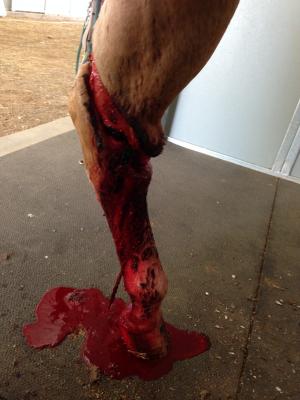 |
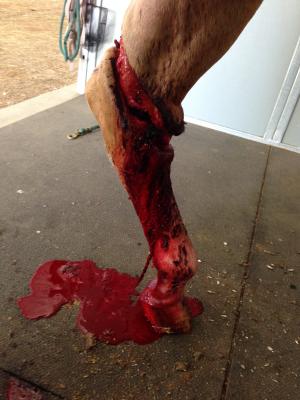 |
After cleaning by the vet at Crossroads Veterinary Clinic - 10/1/13: You can see the cut into the bone and the severed tendons. |
|
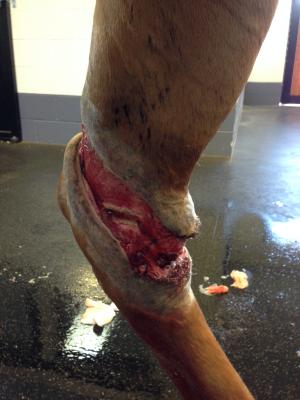 |
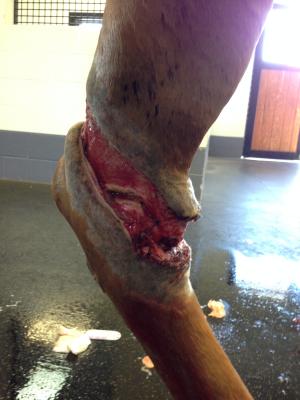 |
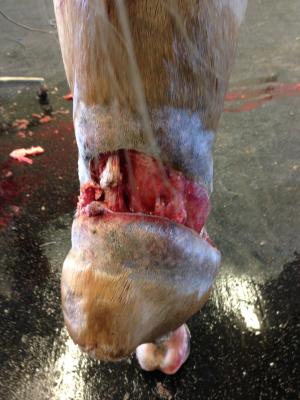 |
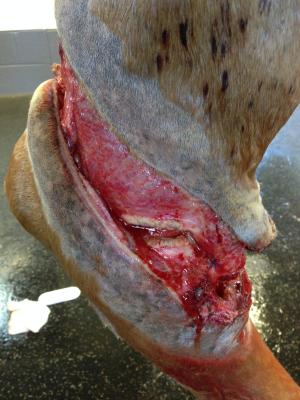 |
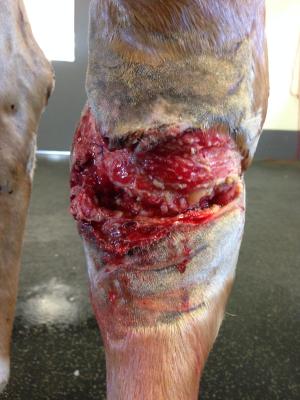 |
|
Twister spent a week and $5K at Crossroads Veterinary Clinic. When their prognosis became grim and an additional minimum cost of $20K my husband said to put him down. I just couldn't do that so I brought him home. Diagnosis and discharge instructions from Crossroads Veterinary Clinic 10/8/13 (pdf) |
This page helped me understand the function of some of these tendons:
There are multiple severed tendons, I have never really been given a clear answer as to exactly which ones. My guess is they don't really know. This entire mechanism is extremely complex.
|
10/18/13: The knuckling over continues to be a big problem. The developing wound on the back of his fetlock is likely from standing like this. Dawn Alves and Kristen Brown of All About Equine came out to look at him and tried to straighten the foot. They were physically unable to move it to a forward position. Dawn is having a Kimzey splint modified (bent) to use on it in the hopes of coaxing it back to a normal position. |
|
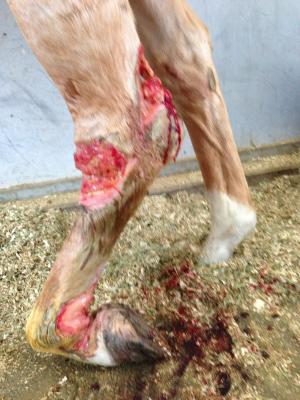 |
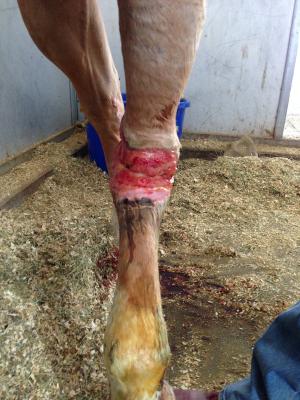 |
10/31/13: After doing some research online, I replaced the Kimzey splint with a custom brace made by Dr. Jolly of Step Ahead Farm. The Kimzey splint is being modified to a more normal position in the meantime. The hope is this brace can maintain the progress made in bringing the foot forward while the Kimzey is being modified. |
|
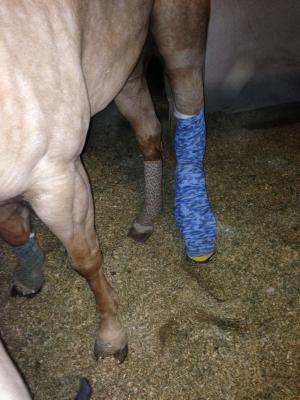 |
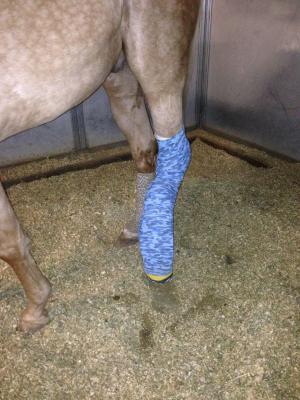 |
11/3/13: Showing brace designed and made by Dr. Jolly of Step Ahead Farm. These pictures show halfway through removing the brace for a bandage change. When applying the brace, I first apply a dressing (with combine around the fetlock and gamgee around the hock) and then wrap that bottom to top with Powerflex (takes two rolls). I then wrap the lower leg with a bath towel folded lengthwise for padding and put another layer of Powerflex wrap on top of that. Then I put the brace on and I put a piece of duct tape around the toe of the brace to the back of his heel. I then use two more rolls of powerflex to wrap the brace to his leg. I have not had any problem at all with the brace coming off or the bandages falling down. I am doing a bandage change every 24 hours. |
|
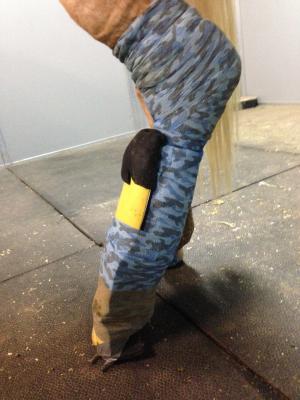 |
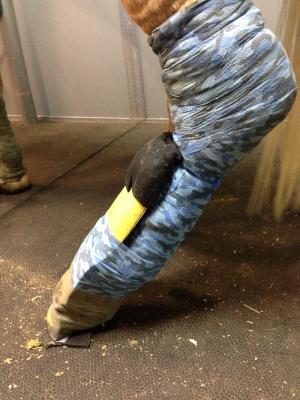 |
11/10/13: Videos of Twister walking with no splint or brace on. It isn't easy trying to take video of your horse walking while you are leading him and walking backwards in front of him!
|
|
|
Bandage change. The vet has agressively trimmed the exposed tendon at the back of the fetlock, and has trimmed some of the excessive granulation tissue. |
|
I have gone to doing a bandage change every 36 hours instead of every 24 hours. Back in the Kimzey splint for now, although I think it needs to be straightened some more to a normal leg position. |
|
11/17/13: Bandage change... He is going for several hours at a time without the splint or brace. |
|
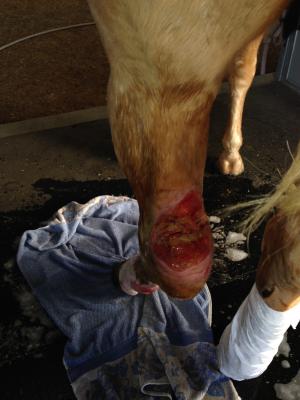 |
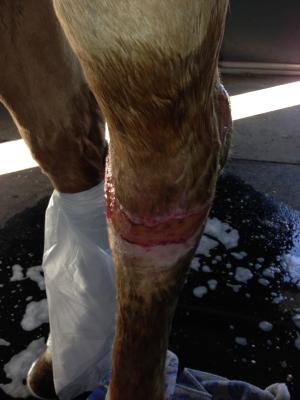 |
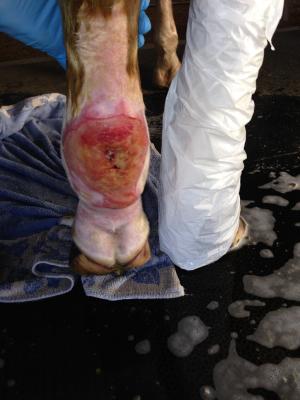 |
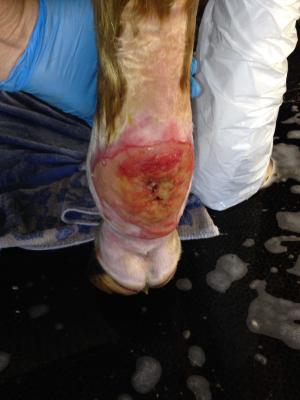 |
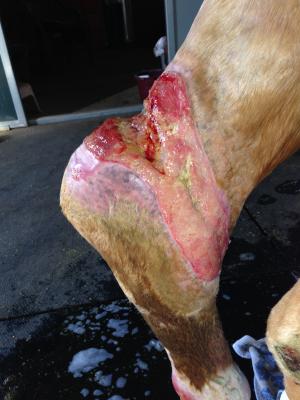 |
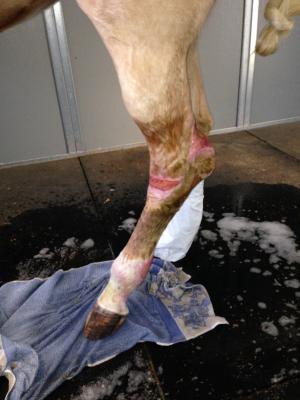 |
11/27/13: This was after going overnight with no brace or splint on... Dogs were all excited and he wanted to take off bucking!! Must be feeling better! |
12/6/13: After several days with no brace on his leg. Doing bandage change every two days now. |
12/13/13: Bandage change... |
|
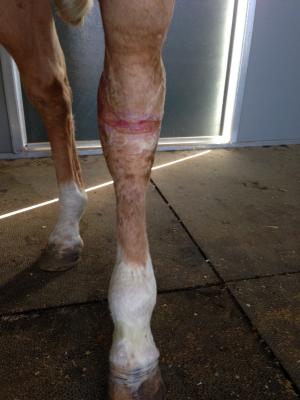 |
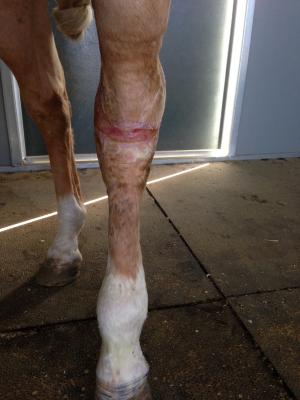 |
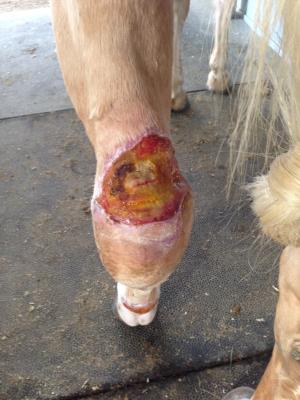 |
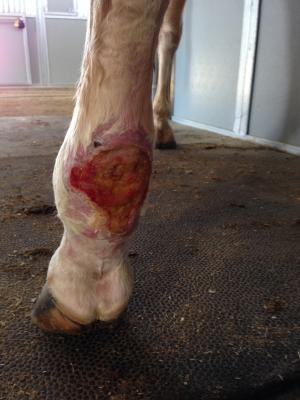 |
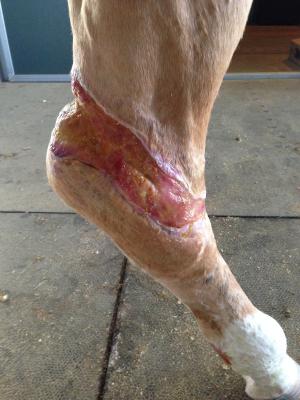 |
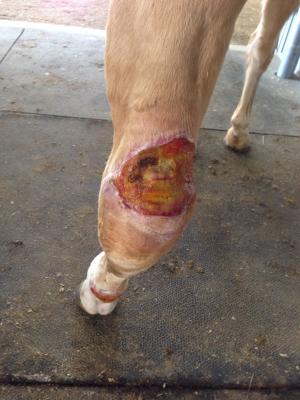 |
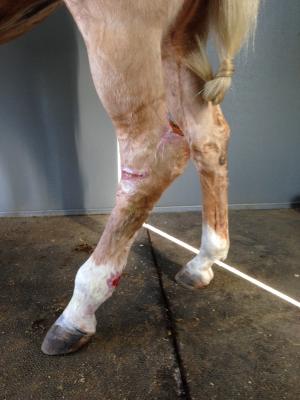 |
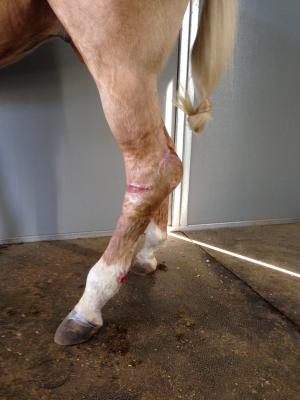 |
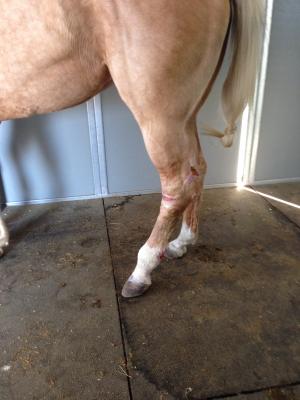 |
|
1/29/14: New complication - he is going to slough off a large part of the hoof wall. |
|
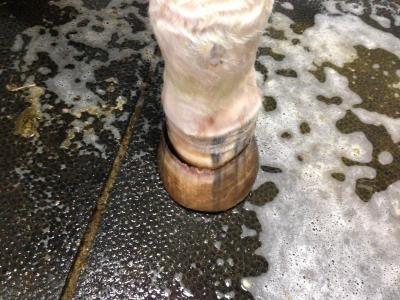 |
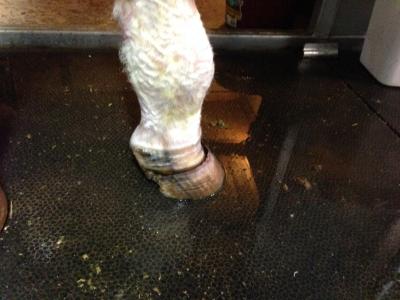 |
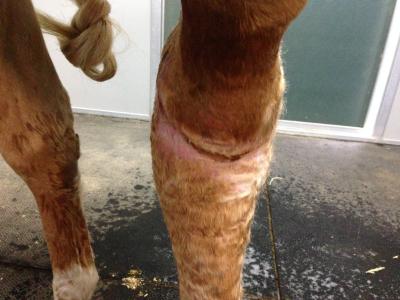 |
|
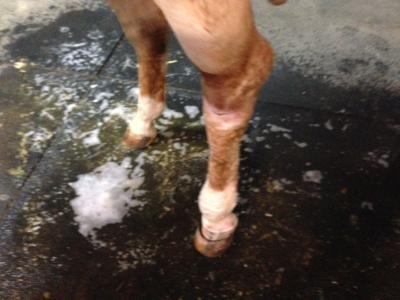 |
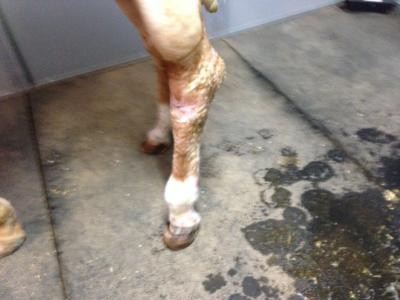 |
2/2/14: After losing part of his hoof. The horn tubules are exposed. Hoof growing in from above appears healthy and the sole is intact, but he is in some pain and his leg above is swollen. Washing daily and keeping it in a Davis boot which seems to help quite a bit. He is back on Bute and SMZs. He has been on a biotin supplement since the injury occurred. Keeping my fingers crossed he can make it through this latest challenge. He is back to being smart and laying down a lot. |
|
2/12/14: I have been struggling with finding a way to protect the impaired hoof. He has no toe so tends to rock over too much when taking a step. There is a lot of drainage and boots tend to hold that drainage in even when holes are drilled in the bottom. I have tried a large variety of boots, pads, etc., none very satisfying. Ten days after hoof sloughed. A very large infected, necrotic swelling has appeared (literally overnight) in the lateral pastern. |
|
2/4/14: Today he started buckling to the lateral side slightly when taking a step. The new wound area is open and draining and sloghing out necrotic tissue. The vet came out to take x-rays. Again the prognosis is grim. The vet recommended putting him down today, but I elected to think about it for a bit more. The x-rays are below. There is no rotation, but there is evidently no collateral support at the coffin joint thus he is tending to buckle to the outside. There is a significant gap on the lateral side, and stress makes it worse. Plus there is the large necrotic infected area on the side of the pastern. It is open and draining now. No way to know if it has invaded the joint. On the x-ray there is a concerning line from the toe to the coffin bone and a shadow underneath. We switched him to a stronger antibiotic (Baytril). I am soaking the foot twice a day in a diluted Betadine solution. He is not in severe pain, but he is on a gram of Bute twice a day. I am trying to figure out a way to support the coffin joint while I try to get the infection under control. I am trying to use a pad under the foot, with an extension and wedge on the outside of the foot and looking for products that might help me. The vet also put forth the theory that this all came from an infection that was draining out of that wound on the back of the fetlock, and when that avenue closed it went elsewhere in the leg. She also proposed the knuckling over he experienced early on could have initiated all of this.
|
|
Note gap on left side of coffin joint.
|
|
2/16/14: Going from bad to worse....
|
|
2/22/14: The infection is now going to start coming out the back as well. The foot is tilting even more. Even I have to admit it is looking pretty hopeless. He is still hanging in there with a good attitude - patiently putting up with soaking, bandaging, medications, etc. |
|
This is from the back. Note how much the hoof has tilted to the inside. |
The old sore that closed up can be seen above. It still isn't completely healed. |
3/9/14: Swelling continues... hoof is going to come off completely. |
|
This is from the back. |
Back of what is left of hoof . |
|
|
|
|
Losing weight... |
|
3/22/14 |
|
|
|
|
|
|
|
|
Starting to gain back some weight. |
4/5/14 I've been leaving his stall door open and giving him the run of the place. He likes to eat the green grass and find a soft place to lay down. Only problem is a few times he has headed down the driveway towards the back 20! |
4/27/14 Maybe ulcerative lymphangitis at this point? Swelling has gone up to the hock. Lots of little drainages pop open, are ineffective, and then close. Lots of serum ooze. SMZs are doing nothing to help. Have tried most every hot, cold, wet, dry, poultice, soak, etc., with no progress. All vets have written him off now. Dawn does not think it is lymphangitis. She thinks it all comes from the infection at the back that is now walled off. Convinced her to give me some Rifampin. Getting really hard to get any meds into him - he hates it. So I mix up Bute, SMZs, Rifampin, water, molasses, and honey in the syringe. I can get most of it in him that way! |
|
|
|
|
|
|
|
|
|
|
|
|
|
|
|
5/30/14 So frustrating getting nowhere. We seemed to be so close back in December! Quit the antibiotics as I don't think they are doing anything. Infection is so walled off nothing can get to it? Any spot that opens up I put a paste of Neosporin mixed with Rifampin on it. Other than his horrible leg, he is fine. He can bear weight and walk just fine. He is turned out most of the time. Attitude and appetite are fine. He is still kind of thin, but not continuing to lose weight at this point. It doesn't seem to hurt him, but he hates having it hosed off. He has started wanting to lick and chew at it. He has managed to get the bottom of the bandaging up a few times. It seems to be a lot of proud flesh, but obviously there must still be infection inside there. The whole leg is still swollen to just above the hock. Additional "walling" happening at the back. |
|
|
|
|
|
|
|